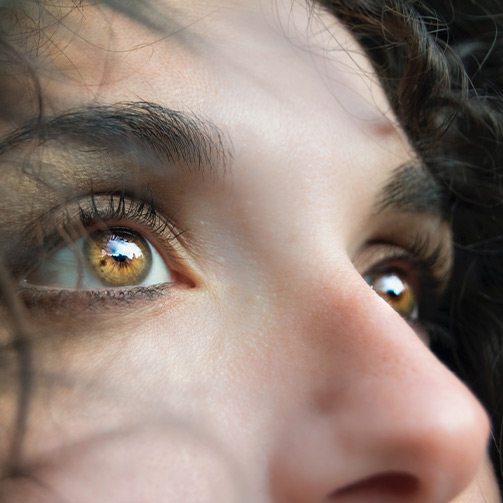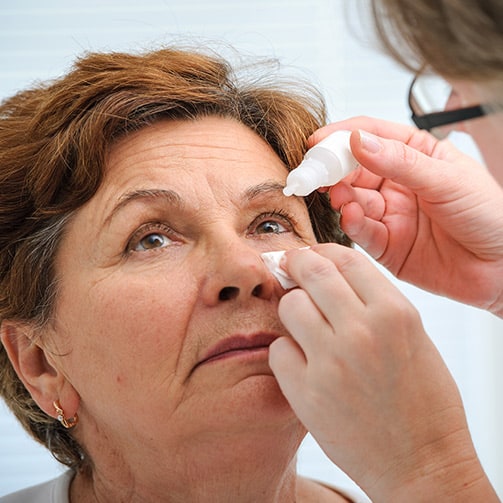Dry Eye Therapy
AND DRY EYE TREATMENT
Did you know
1 IN 3 CANADIANS ARE IMPACTED BY DRY EYE SYMPTOMS?

What causes
DRY EYE DISEASE?
Dry eye disease is a common condition that occurs due to a lack of moisture on the surface of our eyes. It can be temporary or chronic and caused by a variety of factors that include minimal tear production, poor overall tear quality and rapid evaporation. The goal of our optometrists is to properly diagnose and treat dry eye disease before it causes damage to the eye’s surface. Looking for certified in-office treatment to keep your eye health up to date? Contact us today to examine any cause of your dry eye!
What are symptoms of
DRY EYE?
What can cause dry eyes? If you experience dry eye syndrome, your eyes may sting or feel scratchy. There are certain temporary environmental situations where you may have felt this, such as on a plane or staring at a screen for long periods of time. To get some relief, it may be as simple as using prescription eye drops or environmental changes.
If you experience the following symptoms more regularly, however, we recommend booking an optometry exam where we can recommend some dry eye therapies:
- Dryness or itching
- Scratching or burning
- Watery eyes
- Redness
- Mucus
- Light sensitivity or blurred vision
- Difficulty with contact lenses or nighttime driving


Advanced
EYE CARE TESTING AND THERAPY
Dry Eye Speed Questionnaire And Eye Assessment
Do you produce enough tears? Our Dry Eye Speed Questionnaire helps our doctors better understand the frequency and/or severity of a patient’s symptoms. It can also track the overall progress of those undergoing eye exam treatments for dry eye disease.
Keratograph 5M
Diagnostic dye and lissamine green staining
These tests use a yellow or green dye along with a blue or white light to detect damage that may have occurred on the surface of the eye. A piece of blotting paper containing dye is touched to the eye and the patient is asked to blink. This spreads the dye on the tear film and when the blue or white light is directed at the eye, irregularities or damage to the cornea may be uncovered.
TearLab
TearLab is a hand-held instrument that can be used to measure a patient’s tear osmolarity levels, indicating the overall salt concentration found within tears. Patients that receive a score of >300 often have an imbalance of salt and water within their tears, which can be a strong indication of Dry Eye Disease.
We apply the latest diagnostic testing and techniques
in-office. Find relief from dry eyes today with a range of treatment options! Visit us today!
Customized techniques and Dry Eye
TREATMENT & THERAPY Options
What are my treatment options? General health, proper eye care, medications, and environmental factors are all considerations in managing and treating Dry Eye Disease. Our doctors have extensive training and are passionate about staying on top of the newest and best treatments available. We evaluate our patients thoroughly and then design specific treatment plans for each individual.
Intense pulsed light
Intense Pulsed Light, or IPL, is an innovative treatment that helps to break down thicker oils within the meibomian glands to reduce inflammation. IPL can also increase mitochondrial regulation to help our glands produce better quality oils, as well as remove bacteria and large dilated blood vessels on the surface of the skin.
Radio frequency
Radio Frequency, or RF, helps to reduce the overall thickness of oil found within your meibomian glands. It can also help increase oil production while creating tighter skin on your face.
Meibomian gland expression
This test allows us to see if your oil-secreting meibomian glands within the eyelids are clogged. These oils help prevent tear evaporation, which can lead to irritation and inflammation on the surface of the eye. Meibomian gland expression is often completed after IPL and RF treatments, but can also be performed on its own.
Drops
Steroid eye drops are prescription medications that help treat the signs and symptoms of Dry Eye Disease. These options can be filled at your local pharmacy with a referral and can take up to 3 months to take effect.
We also carry a wide variety of preservative and phosphate-free lubricating drops. These drops are often used 2-4 times per day and help to stabilize the lipid layer, allowing for higher tear retention to improve overall comfort throughout the day. These drops can be purchased in our clinic or online.
Finally, plasma-rich platelet drops, or PRP, are made from your own blood, which contains platelets that are rich in healing growth factors, cytokines, albumin and several natural vitamins. These factors help reduce inflammation on the surface of your eyes, which can help treat dry eye symptoms. Patients are referred to a separate clinic for PRP treatments.
Lid cleansers
Good quality lid cleansers can be applied directly onto the eyelids/eyelashes and are helpful in reducing demodex bacteria and inflammation. We carry a wide variety of options and often recommend our patients to use these cleansers between 1-2 times per day.
Environmental factors and diet
We believe in treating eye conditions holistically. There are diet and environmental factors that can also help with dry eye, including using humidifiers, eating carrots, orange peppers and green leafy vegetables and avoiding inflammatory items like gluten and dairy. Learn more
Omega 3s, or “healthy fats”, are also an important part of our diet and treating Dry Eye Disease. They are found in fish, nuts and avocados, but we generally don’t consume enough of these foods throughout the day. It’s also more common to have Omega 6 and 9, or “bad fats”, in our diets, which can lead to further inflammation and dry eye symptoms. Omega 3 supplements can help thin oils that are clogged in the lid margins of your meibomian glands, while also decreasing overall inflammation. .
